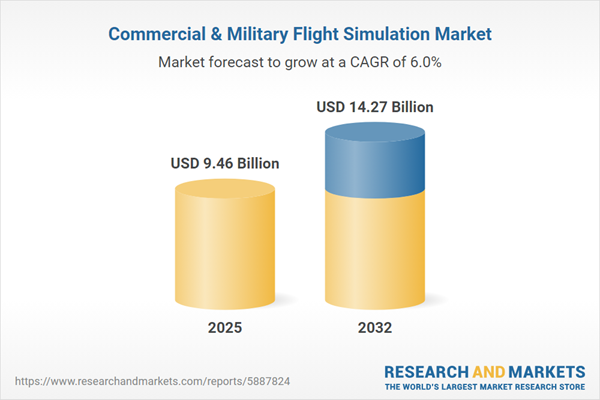Speak directly to the analyst to clarify any post sales queries you may have.
Flight simulation has become a strategic cornerstone for advancing workforce skills, improving operational safety, and maintaining organizational agility across the aviation and defense landscape. Modern simulation technologies give senior decision-makers the confidence to respond proactively as industry demands, regulations, and risks evolve.
Market Snapshot: Commercial & Military Flight Simulation Market
The commercial and military flight simulation market is set for steady expansion, with projections indicating growth from USD 8.93 billion in 2024 to USD 9.46 billion by 2025, climbing further to USD 14.27 billion by 2032, representing a compound annual growth rate (CAGR) of 6.03% over the forecast period.
This sustained trajectory is attributed to robust investment from airlines, defense entities, and specialized training providers. Regulatory requirements for pilot certification, safety, and compliance, coupled with rapid advances in simulation software and immersive training platforms, shape market priorities. The ongoing modernization in both commercial and defense operations fosters adoption of simulation to ensure readiness, efficiency, and alignment with evolving industry standards.Scope & Segmentation: Flight Simulation Market
This comprehensive report provides executive-level insight for technology investments and resource planning across the flight simulation market. Assessment of the complete market ecosystem reveals the main drivers and their impact on efficiency, compliance, and enterprise capability. Senior leaders benefit from an overview of the key segments and technologies influencing market development:
- Product Types: Desktop simulators, entry-level systems, advanced full-flight simulators, and maintenance-focused solutions are utilized in both fixed-wing and rotary-wing scenarios, addressing a range of needs from introductory instruction to complex mission rehearsal.
- End Users: Commercial airlines, military organizations, academic institutions, and aviation academies implement simulation to achieve consistent training outcomes, uphold compliance, and improve certification processes in varied training environments.
- Components: Integrated cockpit systems, motion platforms, sophisticated visual technologies, simulation software, and dedicated support services work together to build adaptable simulation ecosystems for operational flexibility.
- Flight Types: Both fixed-wing and rotary-wing operations incorporate simulation for foundational training, advanced mission preparation, and maintaining readiness for unique operational demands in civilian and defense applications.
- Deployment: Cloud-based models offer enhanced resource efficiency and connectivity, while on-premises installations support secure, continuous operation, particularly for mission-sensitive or regulated environments.
- Geographic Regions: The report covers the Americas, Europe, the Middle East, Africa, and Asia-Pacific, contextualizing modernization initiatives, infrastructure challenges, and evolving regulatory requirements impacting both global and local adoption.
- Leading Companies: CAE Inc., FlightSafety International, L3Harris Technologies, Thales S.A., Lockheed Martin, The Boeing Company, Leonardo S.p.A., BAE Systems, Airbus, and Rheinmetall AG drive market innovation and expand capabilities, often through collaborative development and investment in next-generation technologies.
Key Takeaways: Strategic Insights for Senior Decision-Makers
- Artificial intelligence and immersive solutions are elevating simulation realism, enabling organizations to deliver adaptable, high-fidelity training for shifting operational requirements.
- Modular system designs provide scalable upgrade pathways, reducing both training downtime and the potential for compliance-related interruptions.
- Collaboration between solution providers and training institutions enables rapid response to changing workforce needs, optimizing program outcomes and resource allocation.
- Simulation platforms are supporting the emergence of urban air mobility and the execution of advanced rotary-wing missions, preparing organizations for a broader range of operational scenarios.
- Regional customization of simulation programs addresses localized infrastructure and regulatory challenges while ensuring adherence to international standards.
- Synthetic and augmented reality technologies are updating training content continuously, supporting resilient preparedness even as external conditions shift.
Tariff Impact on Supply Chains and Strategies
Recent changes in U.S. tariffs are prompting organizations to reevaluate sourcing strategies and explore near-shoring to enhance supply chain robustness and operational continuity. Transitioning to subscription-based simulation software and phased updates of hardware is streamlining capital investment and strengthening the flexibility of training program delivery. These measures allow organizations to sustain training performance and maintain cost control as policy conditions evolve.
Methodology & Data Sources
The insights in this report are based on primary research, direct engagement with subject matter experts, and in-depth analysis from market specialists. Triangulation of data sources and validation processes underpin the reliability of findings, offering stakeholders in flight simulation clear direction for procurement and technology decisions.
Why This Report Matters
- Enables data-driven decisions for simulation technology investments as regulatory and operational frameworks advance.
- Supports the strategic development of advanced, agile training programs in anticipation of future industry and compliance challenges.
- Provides actionable strategies for supply chain management and collaboration to proactively address market, technology, and policy risks.
Conclusion
This report empowers decision-makers to refine simulation-based initiatives, maximize workforce performance, maintain agility, and achieve sustained success in the evolving aviation and defense sectors.
Additional Product Information:
- Purchase of this report includes 1 year online access with quarterly updates.
- This report can be updated on request. Please contact our Customer Experience team using the Ask a Question widget on our website.
Table of Contents
3. Executive Summary
4. Market Overview
7. Cumulative Impact of Artificial Intelligence 2025
Companies Mentioned
The companies profiled in this Commercial & Military Flight Simulation market report include:- CAE Inc.
- FlightSafety International Inc.
- L3Harris Technologies, Inc.
- Thales S.A.
- Lockheed Martin Corporation
- The Boeing Company
- Leonardo S.p.A.
- BAE Systems PLC
- Airbus SE
- Rheinmetall AG
Table Information
| Report Attribute | Details |
|---|---|
| No. of Pages | 181 |
| Published | November 2025 |
| Forecast Period | 2025 - 2032 |
| Estimated Market Value ( USD | $ 9.46 Billion |
| Forecasted Market Value ( USD | $ 14.27 Billion |
| Compound Annual Growth Rate | 6.0% |
| Regions Covered | Global |
| No. of Companies Mentioned | 11 |









